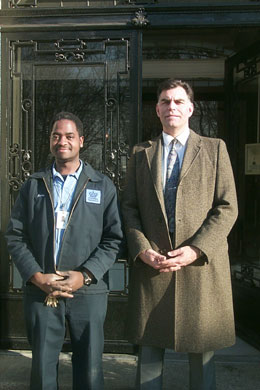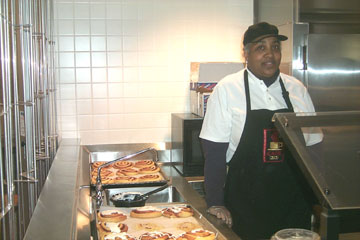
|
|
Andre Whitaker (left) with housing supervisor Peter Hoff
|
When Andre Whitaker moved to Harlem in 1996 in search of opportunity, he found a high cost of living and a limited job market instead. Struggling on and off public assistance to make ends meet, Whitaker enrolled in a building superintendent training course run by the City of New York, and through the Times Square Common Ground Community Organization, he worked on a short-term contract as a project supervisor.
"When it was over, I had no job connections until I met John Sanful," said Whitaker.
It was Sanful, director of the Morningside Area Alliance's Job Connections, who became his link to a job. Sanful helped Whitaker clean up his resume, schooled him on how to effectively present himself when interviewing and even required Whitaker to wear a tie when he walked into the Job Connections office. But perhaps most importantly, Sanful stayed in touch with Whitaker, providing words of encouragement as Whitaker waited to be linked with a job in an Upper Manhattan institution. In June 1999, Whitaker got a job at Columbia as a casual employee, one of the University's first Job Connections hires.
"Everything fell right into line, and Job Connections was a big part of it," said Whitaker. "If they hadn't stayed on me, I might have given up."
But Whitaker is not the only one to win in this exchange. According to Nelson Falcon, housing supervisor with Columbia's Institutional Real Estate Department, Whitaker is reliable, dedicated and goes "above and beyond" the requirements of his job. Any employer would say he was a real find, and Falcon has offered him a permanent position. Whitaker begins his new job as the handiman for eight buildings on Riverside Drive on March 6.
Job Connections has placed 44 skilled workers from Upper Manhattan into jobs in the area and of those, 33 have been linked with jobs at Columbia through a carefully nurtured partnership between Job Connections and people within the University.
"This program has grown through the honest efforts of committed people from community organizations, the Morningside Area Alliance and other institutions like Columbia, who have formed a human bridge to opportunity within their own communities," said Emily Lloyd, executive vice president for administration at Columbia.
"At Columbia we have the opportunity to contribute to the economic well being of our surrounding communities by encouraging local spending and hiring. The University has been active in recruiting minority and local workers for construction projects both on and off campus for years, and as one of the largest private employers in New York City, there are ongoing opportunities for permanent employment. With their grass-roots outreach, Job Connections is able to help us connect the right person with the right job, linking local residents with the University, one person at a time, " said Lloyd.
In February 1999, Job Connections was created by the Morningside Area Alliance, a not-for-profit organization that has been engaged in community-building initiatives for over 50 years. A natural supplement to an existing program, job Connections grew from the already existing network between the Alliance's 17 member institutions, including Columbia, and community-based job training and vocational organizations in Upper Manhattan to facilitate employment opportunities for residents of Upper Manhattan.
Innovative in its grass-roots approach, Job Connections is cultivating an ever-expanding network of community organizations, now numbering 26, among them Harlem Congregation for Community Improvement, Non-Traditional Employment for Women and the Northern Manhattan Improvement Corporation. The dedicated people of these organizations act as Sanful's eyes and ears by locating experienced but under-employed individuals in the community and forwarding them on to Job Connections. Then, Sanful brokers the relationship with the human resources departments of major institutions, where jobs are available.
At the onset of the program Columbia was an anchor, facilitator and ultimately became the model for other institutions interested in stimulating Job Connections' human links that personify the program's success.
Job Connections' growing applicant pool includes college graduates, people with technical training, skilled workers and individuals with years of work experience who are in search of better opportunities but were unable to find jobs locally in their field. Many were discouraged with the seemingly endless and often impersonal process of job hunting.
Of his pool of maintenance candidates, Sanful notes that people have on average 12 years of total work experience and six years experience in maintenance work. Twelve have technical certificates; most have completed school; and two have college degrees. To date, 35 maintenance candidates have been placed in positions.
In the administrative assistants pool, 14 out of 40 have college degrees; four have done post-graduate work; and four have associates degrees.
Making Links Stick: Columbia Boosts Job Connections
In a year's time 33 skilled local residents have found positions at Columbia as food-service workers, custodians, porters, facilities workers and administrative assistants in a variety of departments--the Libraries, Institutional Real Estate, Dining Services, Facilities Management and University Residence Halls--both casually and permanently.

|
|
Kim Wells
|
For a program that relies on people for its success, Columbia had to think strategically about how to link people with people at the grass-roots level. Human Resources succeeded by laying the framework within the institution and building a working partnership between Job Connections and individual departments within the University. By putting John Sanful and other Job Connections counselors in touch with department managers in need of workers with certain skills, Columbia established the personal relationships that served to boost the program toward further success. Managers could talk about what they needed, and Sanful could sift through his pool of applicants to find the ideal candidate. Now in addition to linking directly with hiring managers he knows, John Sanful also meets weekly with a Human Resources representative to identify other needs within the University.
"To make this program successful at Columbia, Human Resources invested time up front," said Colleen Crooker, vice president for Human Resources. "Our team, led by HR Director Donna Rey, worked hard to identify the jobs that would provide a likely match for potential candidates, identified the skills that candidates would need to be competitive and then introduced John Sanful to hiring managers. John took it from there. Since that time, he has built solid relationships with Human Resources and hiring managers where he is trusted to bring in quality candidates who are good fits for the jobs they are hired to do. And he does."
"The result is win-win. Job Connections has already proven to be a great resource for Columbia in its efforts to hire good people, especially women interested in non-traditional employment. We are particularly pleased that we are able to support the surrounding community in the process," said Crooker.
"We are opening up pipelines to people," said Sanful. "When a hiring manager receives a resume from us, they know that person is pre-screened and job ready. Once we link the candidate with a manager for an interview, they are on their own."
Kim Walls is a model example. "When I interviewed with the manager of dining services (at Columbia), he looked at my resume and asked: You have 21 years of experience in retail?" said Walls, who was hired immediately following her interview and now works at Columbia's newest dining venue, Cafe 212.
Temping Opens the Door to Experience, Jobs
Many Job Connections applicants find that opportunity at Columbia begins with temporary employment. For example, IRE uses temporary workers frequently and when a permanent position becomes available, they draw the best candidates from the pool. For managers at Columbia, Job Connections is another recruiting tool and a real plus, especially when looking for women interested in non-traditional employment. To date IRE has hired 15 Job Connections people who have worked as casuals and 6 have been retained.
Coming onboard as a casual worked for Miriam Wells, who lives within blocks of the University. After four months at Cafe 212, she is working full-time, is member of Local 1199, and has a competitive salary and full benefits. "If I wasn't having fun, I wouldn't be here," she said, noting that through rain or snow, she will be on time.
"Even if they work for two months, having Columbia University, a premiere academic institution, on their resume is a great plus," said Falcon of IRE. "Their time with us gives them training and a potential recommendation for the next position."
Job Connections candidates who became Columbia employees can attest to the opportunities at Columbia.
According to Kim Walls, who watched a Job Connections colleague move from Food Services to Facilities Management, once you "have your foot in the door" at Columbia, you will have number of opportunities to move up and on.
For Andre Whitaker of Harlem, Columbia has been the land of opportunity and Job Connections opened the door. Whitaker walked into a position as a porter. Now he is using the technical skills he learns in night school in his new job as a handyman for IRE. "There is so much opportunity to move up as long as you improve yourself along the way," said Whitaker, who plans to stay with Columbia.
|
